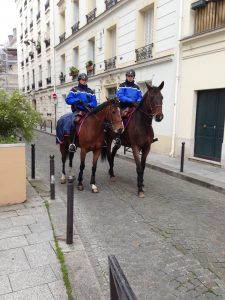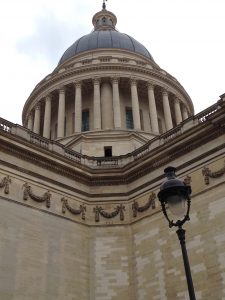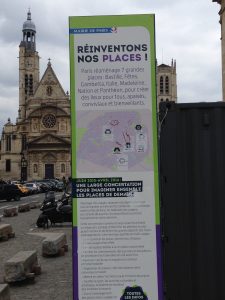
I love the 5th arrondissement of Paris. When I arrived in Paris in my early twenties, I discovered the rue Mouffetard, one of the oldest market streets in Paris. I rented a small studio with a toilet on the landing – and in spite of that inconvenience thought I’d died and gone to heaven. I loved leaning out my sole window on the third floor to sniff the smells of the market and rejoice in the noise and the hustle and bustle and the cries of the vendors as they rushed to place their stalls and their wares.
Years and years have passed since then. I’ve gone from being a carefree, adventurous twenty- something-year-old single woman to being a I-won’t-tell-you-how-old grandmother! I’ve lived in other spots in Paris – the upscale 16th and Neuilly where we practically lived in the Bois de Boulogne and now the 20th, near the Père Lachaise cemetery.
I still love the 5th best of all.
As a matter or fact, it took me a long time to bid good-bye to the 5th. After I left the rue Mouffetard, I moved up the street, first to the rue Descartes and then to the rue de l’Ecole Polytechnique; I married my French husband at the “Mairie” of the 5th arrondissement right across the street from the Pantheon; after he retired, my husband got his doctoral degree in History at the Sorbonne.
Maybe one reason my husband and I both like the 5th so much is that it is filled with great institutions of learning – the Sorbonne, of course, but also Le Collège de France and L’Ecole Normale Supérieure. Unlike certain parts of Paris, the 5th doesn’t put on airs but is comfortable just being itself. And while it’s lively, sometimes, rather eerily, you’ll find yourself on a street that is as quiet is if you were in the country. The picture above of the officers on horseback was taken on Easter Monday when my husband and I were walking down the rue Aymot, not far from the Place de la Contrescarpe and the Institut Curie. There was not a soul or a sound – until a clip clop, clip clop reached our ears. We turned to look and voilà in our line of vision, two handsome horses mounted by officers of the Gendarmerie Nationale who kindly stopped to pose for the picture before moving on at a leisurely pace.

We continued our stroll until we reached the Place de Pantheon. With its impressive dome and intricately decorated Corinthian columns, this beloved neoClassical monument modelled after the Pantheon of Rome is the collective resting place of France’s greatest men and women from Victor Hugo and Alexandre Dumas to Geneviève de Gaulle-Anthonioz and Simone Veil. On its pediment you’ll see the motto: aux grands hommes la patrie reconnaissante (to the great men, the gratitude of the country). Hard to change the writing on a pediment but, as mentioned, the Pantheon is home to the remains of some of France’s greatest women as well as men. A stately building, it dominates one of the most beautiful “places” in Paris. With your back to its front, you look straight down to the Luxembourg Garden. Facing it, you see behind it on the left the ancient Eglise Sainte-Genevieve. It is a very special historic place in the heart of the city.
Imagine my consternation, then, when I spied a series of ugly horizontal blocks on either side of the monument making the entire esplanade look like a work site. I couldn’t figure out what they were or imagine they could be “benches” – but they are, just as the platforms of wooden slats are a place for skateboarders or budding actors to declaim their texts. What a scandalous shame, I thought, and laughed when I saw that some impish soul had placed a mask on the nose of the statue of the famous 17th century French dramatist and tragedian Pierre Corneille. I imagined him saying “this new idea stinks”! Or “speaking of tragedies” !

A planned tragedy, at that. As you’ll see on the sign below which explains the desecration, the benches are part of a comprehensive project of the City of Paris and its Mayor Anne Hidalgo to make several Paris “places” more user friendly. The idea, I can only assume, is that all these boring age-old “places” should be fun-filled. That means smoking and eating sandwiches and skate boarding and sitting back and relaxing on the backless granite benches (if you can relax on a backless bench) instead of doing what people used to do which was take a stroll, stop in front of the monument, appreciate its beauty while standing and move on. The idea is to “re-invent” the places mentioned in the poster.

I’ve got a better idea. Just leave them alone. Give people a chance to enjoy beauty without the noise of skateboards, music blaring from earphones, constant flap and flutter.
If there’s silence, they might even hear the surprising sound of horses hooves!
I’m with you, Harriet. If it ain’t broke, don’t fix it!!!!!! And the Pantheon and its place is a lovely and inspiring area. Thank you for speaking your mind.
Thanks, Claudia. I think it’s important to give one’s opinion on “urban blight” and am glad you agree with me that the Pantheon and its place deserves to remain the lovely, inspiring area that it is. Harriet
I’m so with your line of thought, Harriet. Sad.
Thanks, Anna. It’s just too bad that Madame Hidalgo doesn’t consult with her constituents. This city deserves beauty!
I agree Harriet, so unnecessary. Certainly not worth the expense. I’d much rather sit at a cafe or in a lovely park after a Flaneur.
I think that we taxpayers should be consulted and that Paris projects should beautify the monuments and the surrounding areas rather than spoil them! Unfortunately we are not consulted and many of the projects are either mediocre or ugly. So unfortunate! Thanks for your comment. Harriet
And the benches themselves are so cold looking and ugly, not even the charm of benches seen elsewhere in Paris.
Loved the walk down memory lane and you are so lucky to be able to flaner like this in so many places. Not unlike Proust dipping his madeleine in a cup of tea, your walk in the 5th brings you back to those wonderful days of your youth. I get the same feeling when I walk down the rue des belles feuilles, not far from Trocadero, where I lived for 3 months. Although it’s changed so much (a little china town of sorts), I’m still 20 something when I walk down it and remember the book store I worked in and the little stores where I did my shopping each day.
Thanks for taking us through the 5th. Great post, as always
I am glad you enjoyed my walk down memory lane (and you can’t imagine how many “memory spots” I cut out!). Benches are wonderful to sit on when they are well-designed and aesthetic which is absolutely not the case of what has been placed around the Pantheon or in other Paris places. One has to keep an eye on urban developments – without consultation, they happen fast and once they’re there, it’s hard (impossible) to get them down. Just look at the Tour Montparnasse and Jussieu, two eyesores (in my opinion) on the Paris horizon. Thanks for writing. Harriet
Harriet, thank you for yet another rich and thought-provoking piece providing a glimpse into Paris, albeit this time on a heavier note. As an architect who has carefully designed public space in other cities, I couldn’t agree more on the importance of good civic design which can only be arrived at through a consultative process with constituents and the necessity of time that this entails. Is it possible that what you are witnessing at The Pantheon and other similar sites in Paris are relatively hastily deployed security bolards explained away as public benches? From afar one can’t help but see the relatively recent events in Nice and today’s news of a van that drove into a crowd in Muenster, Germany, as one possible catalyst for such crude and hastily deployed measures that might be serving an immigrate security imperative?
Here in Australia our own Parliament House in Canberra, designed as a building that could be ascended via a lawn that covers the roof in a symbolic, democratic subjugation of politicians under the feet of constituents, has now been rendered inaccessible by a 2.5m high security fence in a move triggered by Nice that now deprives the building of its core original concept:
http://mobile.abc.net.au/news/2017-09-12/security-fences-shut-patrons-out-parliament-house-grassy-slopes/8896074
Hopefully with time Paris’ exemplary understanding of the importance of well designed public space will see the Pantheon’s surrounds transformed into a ‘place’ deserving of its building’s civic import.
P.S. Every time I have visited the Pantheon’s ‘place’ in the past I’ve have found it to be disappointingly bleak and inhospitable as a public space. Admittedly the building itself has been under restoration for many of these visits of mine but the public space around it always struck me as one part of Paris crying out for a softening with trees and truly inviting public space so, underlying rationale aside, I wholeheartedly agree with your call for better public space design and consultation!
Happy to have you, an architect who has designed public space in various cities, commenting on my piece about the use of the space around the Pantheon. How different this space could have ended up looking had there been careful consultation, ideas and proposals from different architects. Maybe we would have seen designs incorporating lovely benches, plants and trees. Or maybe someone would have proposed a project that plays with and complements the rather austere building in a more “mineral” way, making the entire space a coherent entity.
Thank you for sharing the story about the Parliament House in Canberra whose very purpose has been defeated – I love the idea of the lawn on the roof as a symbolic subjugation of politicians under the feet of constituents! You would never see that here – or at least, not at present. Thanks so much for casting your expert judgment on this important subject. Harriet